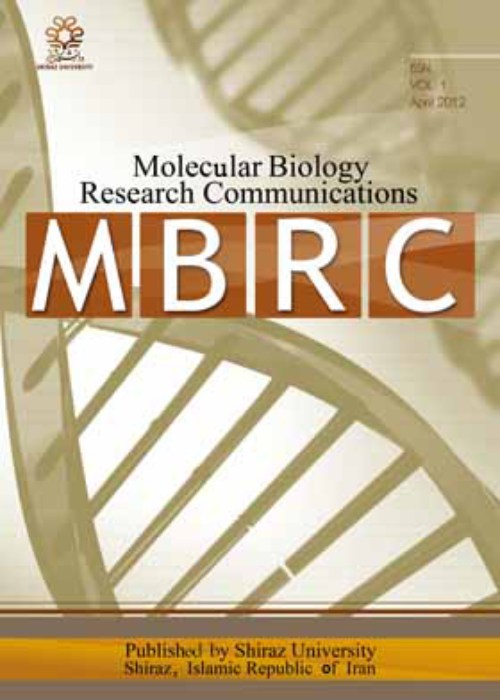فهرست مطالب
Molecular Biology Research Communications
Volume:12 Issue: 2, Jun 2023
- تاریخ انتشار: 1402/05/07
- تعداد عناوین: 5
-
-
Pages 57-62Neovascular age-related macular degeneration (nAMD) is a progressive ocular disease, responsible for central visual loss and blindness in elderly population. Increase data demonstrate that genetic factors play an important role in pathogenesis process of this disease. The aim of this study is to investigate the association between rs3732378 polymorphism in CX3CR1 gene and nAMD in a sample of Algerian patients. This case-control study consisted of 72 patients with nAMD and 124 control subjects. DNA of participants was extracted using salting out method. Genotyping was carried out using the TaqMan real-time polymerase chain reaction method. Statistical analysis was performed by SPSS.21.0. The prevalence of the risk genotype AA was higher in the nAMD group than in control group (OR=5.02, 95% CI=1.44-17.4, P=0.011). In our sample of Algerian patients, the rs3732378 polymorphism is associated with nAMD. This result may support the role of CX3CR1 gene in the pathogenesis of nAMD.Keywords: Neovascular age-related macular degeneration, CX3CR1, Polymorphism, Algerian Population
-
Pages 63-70Prostate cancer is a disease that depends on androgenic stimulation and is thus commonly treated with androgen deprivation therapy (ADT). ADT is highly successful initially; however, patients inevitably relapse at which point the cancer grows independently of androgens and is termed castration-resistant prostate cancer (CRPC). CRPC develops through various mechanisms, one of these being crosstalk of the androgen receptor (AR) signaling pathway with other signaling pathways. Congruently, prior work has shown that androgen deprivation induces SHH signaling, which subsequently promotes activation of AR-dependent gene expression to promote cell growth. Mechanistically, this crosstalk involves a physical interaction between AR and components of SHH signaling, specifically proteins of the GLI transcription factor family. These findings thus suggest that activation of SHH signaling could promote the recurrence of cell growth in the absence of androgens to ultimately lead to progression towards CRPC. In this study, we have investigated this mechanism in a subset of prostate cancer that harbors genetic alterations within the Mediator subunit 12 (MED12). We found that loss of MED12 promotes the expression of GLI3 target genes which subsequently drives excessive cell growth in the absence of androgens. Thus, we conclude that genetic alterations within MED12 promote CRPC through hyperactivated GLI3 dependent sonic hedgehog signaling.Keywords: MED12, castration-resistant prostate cancer, SHH signaling, GLI3, tumorigenesis
-
Pages 71-76
There has been a concerning increase in the incidence of autoimmune diseases following SARS-CoV-2 infection, with molecular mimicry proposed as a potential mechanism. Our study identified nine fertility-associated proteins (AMH, BMP2, CUBN, DNER, ERCC1, KASH5, MSLN, TPO, and ZP3) that exhibit potential molecular mimicry with MHC-II epitopes of SARS-CoV-2 proteins (N, ORF1A, ORF1AB, and S). We screened for epitopes based on in silico binding using DR-, DQ-, and DP-haplotypes that predispose susceptible individuals to autoimmune diseases. Our systematic analysis revealed that 41 countries with population coverage of over 50% had a pre-COVID pandemic total fertility rate of less than 2.1 births per woman. With over 761 million people from 229 countries and territories infected since December 2019, there may be a potential for a foreseeable negative effect on fertility in specific countries, particularly in high-income economies experiencing rapid demographic changes.
Keywords: SARS-CoV-2, Autoimmune diseases, Molecular mimicry, Fertility, MHC-II epitopes, In silico binding -
Pages 77-85Epithelial-to-mesenchymal transition (EMT) plays a critical role in colorectal cancer (CRC) metastasis. In the present study, we evaluated the effects of annexin A5 (ANXA5) overexpression on invasiveness as well as the expression of genes involved in EMT of HCT 116 cell line. PCMV6-AC-IRES-GFP plasmid harboring ANXA5 cDNA was constructed. HCT 116 cell line was transfected with recombinant plasmids using Lipofectamine 3000. Fluorescent microscopy was used to determine the efficiency of plasmid transfection. Cell viability was determined using the MTT assay. HCT 116 cell migration was evaluated using wound healing assay and transwell migration assay. Real-time quantitative polymerase chain reaction (RT-qPCR) was used to measure the expression of genes involved in EMT. The results of RT-qPCR showed overexpression of ANXA5 compared to the control group. ANXA5 overexpression had no significant effects on cell viability but significantly decreased the rate of wound closure in the wound healing assay as well as the number of migrated cells in transwell assay. Furthermore, ANXA5 overexpression decreased the expression of N-cadherin, Snail, Slug, MMP-2, and MMP-9 while the expression of E-cadherin increased following ANXA5 overexpression. However, VEGF expression did not significantly change after ANXA5 overexpression. Results of the present study suggest that ANXA5 overexpression might have inhibitory effects on the metastasis of CRC through modulating the expression of EMT- related genes.Keywords: Colorectal cancer, Epithelial to mesenchymal transition, Metastasis, ANXA5
-
Pages 87-94Canine hepatozoonosis is a tick-transmitted apicomplexan infection caused by two species of Hepatozoon, H. canis, and H. americanum. The present research aimed at detection of Hepatozoon spp. in dogs and its effects on hematological alterations. Blood samples were taken from 108 dogs to assess Hepatozoon spp. Phylogenetic analysis was performed based on the 18S rDNA marker by PCR assay and Giemsa-stained blood smear examination. Of the 108 blood samples of dogs tested in the present study, eight (7.40%, 95% CI: 3.25-14.07%) were positive by the Hepatozoon-specific PCR assay. However, in the microscopic examination, only one sample (0.93%) was positive. All of the sequenced samples were H. canis. The Hepatozoon sequences obtained from PCR amplicons in the canine-positive cases exhibited 100% similarity to each other and 98.47-100% similarity to other relevant sequences in GenBank. These findings represent the first molecular evidence of H. canis in dog populations in South Iran. Furthermore, according to the hematological analysis, significantly higher average numbers of neutrophils and lymphocytes were found in the infected group compared to the non-infected dogs. In this study, no statistically significant connection (P<0.05) was observed between H. canis infection and the examined risk factors.Keywords: Hepatozoon canis, Molecular detection, dog, Hematological analysis


